Letter from Africa: The great train safari from Tanzania to Zambia
- Published
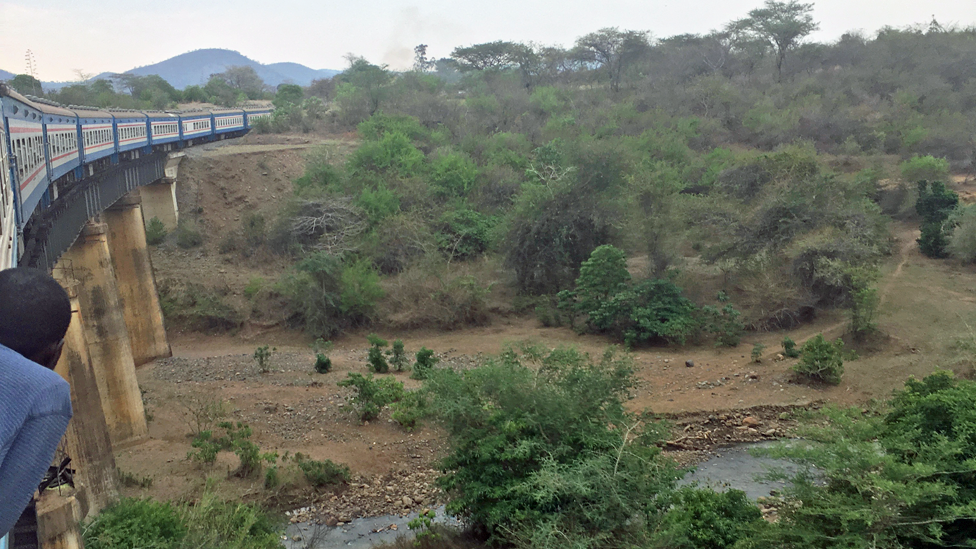
In our series of letters from African journalists, Ismail Einashe boards the Tazara express, fulfilling a long-cherished dream to travel along what is also called the "uhuru railway", meaning "freedom railway" in Swahili.
On a sticky, humid afternoon I embarked on an epic 1,860km (1,155-mile) 52-hour train ride on board the Tazara line from Tanzania's commercial capital Dar es Salaam into Kapiri Mposhi in the heart of Zambia's copper belt.
Built by the Chinese in the 1970s, the significance of the much-celebrated post-colonial railway line has diminished as Zambia now has other outlets to export its copper.
Nonetheless the project heralded a defining moment in China-Africa relations as today China is the continent's single largest trading partner and its most important investor - and the trains remain popular with passengers.
Travel of a bygone era
Ever since I heard about the Tazara line as a teen I have dreamt of one day taking it.
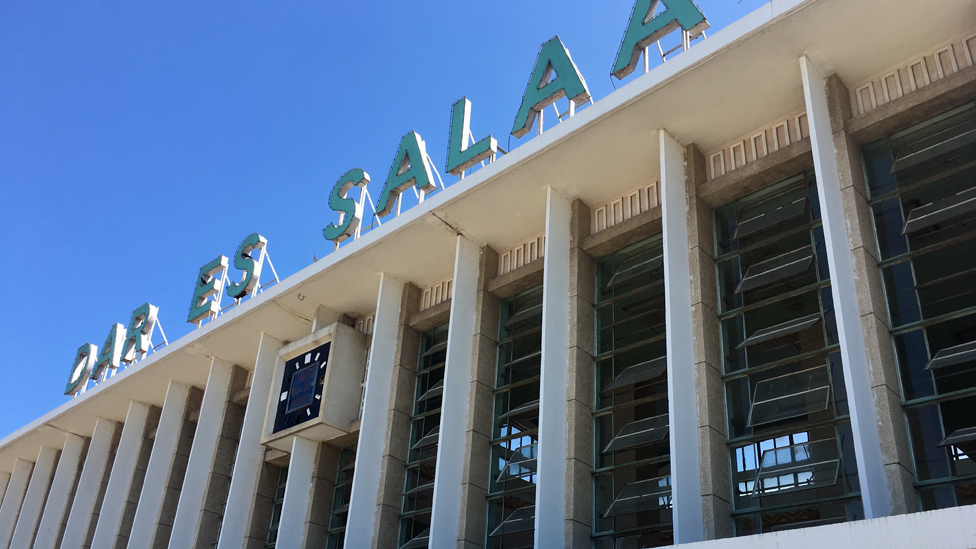
The Tazara line was built by the Chinese in the 1970s
It is one of Africa's last true great railway journeys - sweeping across a large stretch of eastern and southern Africa.
The Tazara station in Dar es Salaam is a beautiful masterpiece of 1970s Communist modernist architecture with a central staircase running through the enormous cathedral-sized hall. With airy huge windows, neatly arranged seating areas, faded lime green walls and general decay, it transports you back to train travel of a bygone era.
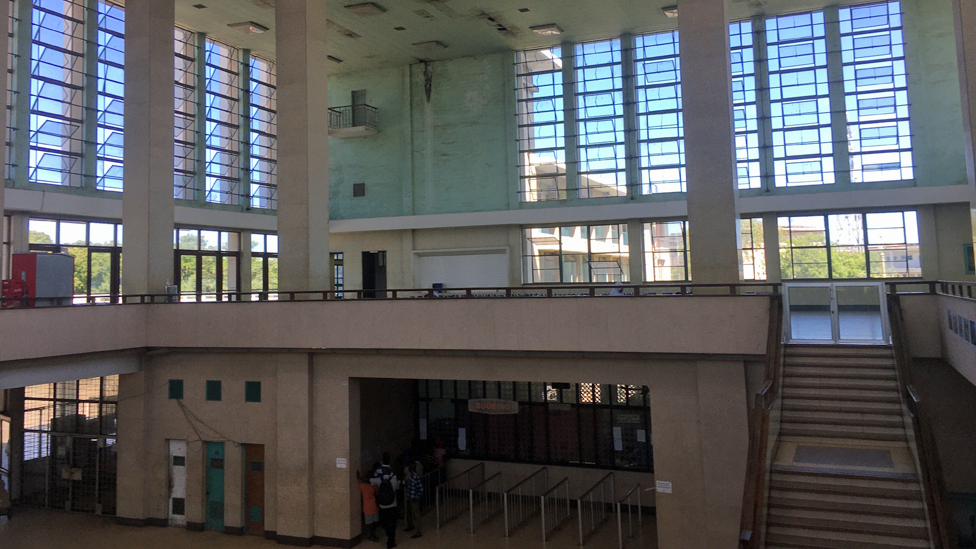
The Dar es Salaam station is a masterpiece of Communist modernist architecture
A one-way first-class express ticket cost me $45 (£34). Each compartment was arranged into sexes: first-class slept four, second-class six, and third-class had no beds just seats.
The train was so packed out that at night some slept in the corridors.
I shared mine with two others on our two-night and three-day journey: a Zambian farmer from the copper belt, who had spent time in Tanzania buying seeds, plants for his farm and bags of rice for his family; and a young South Korean, who had completed his military service and was on his way to see Victoria Falls.
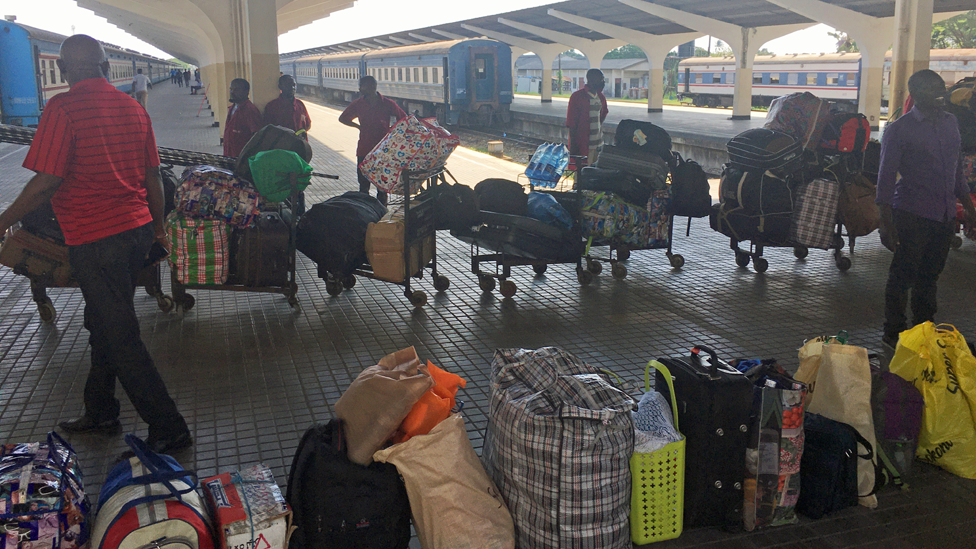
The train was filled with passengers and their luggage when it set off from Dar es Salaam
The train we were in, I was told, was operated by the Zambians and was generally in better condition than those run by the Tanzanians.
The model was from 1976 and had been in operation ever since.
It had running water, that occasionally worked, and there was a shower over the toilet, which was literally a hole over the tracks.
'As slow as a bicycle'
The train, with its occasional jolts and shakes, sometimes felt as if it was coming unstuck - and I could see the odd old carriage lying by side of the tracks, which was not encouraging for someone with a weak stomach on a bumpy journey.

Vendors did a brisk trade at train stops in Tanzania
As we made our way across Tanzania's southern highlands, the speeds dipped below 30km an hour - at times it felt like the train was moving at the speed of a bicycle.
Whenever we stopped whole villages would turn out to greet us. Women would run with baskets teaming with fruits, bananas, avocados, rice and sweets to sell.
There's something soothing about long train travel. The delays and slow pace give the mind time for introspection. You realise just how far distances can be"

And children would jump in giddy excitement, waving and shouting "karibu" - "welcome" in Swahili.
Shared confidences
On the first night I could hear hyenas in the distance and saw the clearest skies I had ever seen.
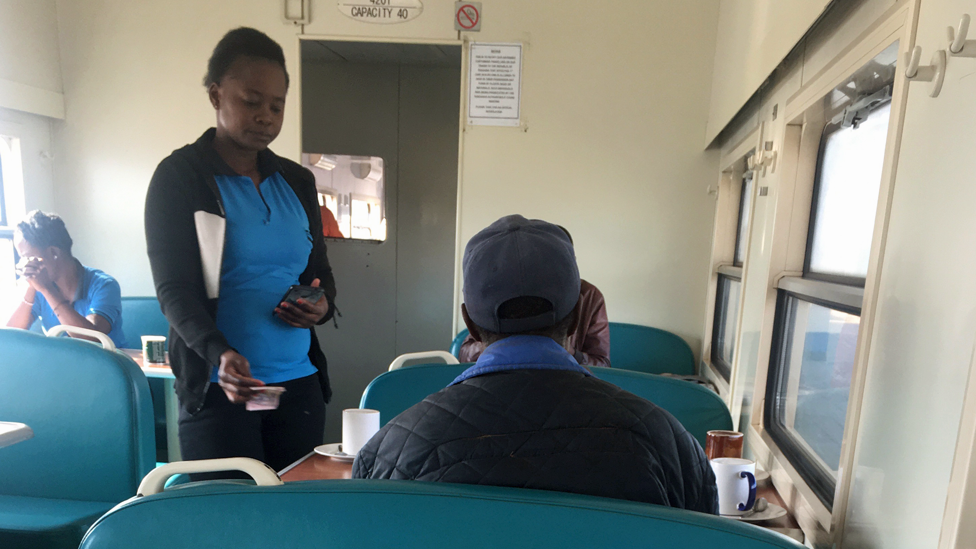
The restaurant only served two meals - chicken with rice or beef with rice
There's something soothing about long train travel. The delays and slow pace give the mind time for introspection.
You realise just how far distances can be. In the modern world we are so used to calling an Uber at the click of a thumb or flying between cities so easily.
The train had a restaurant carriage where the same meals were served every day: chicken with rice or beef with rice.
I met an array of fascinating characters - it felt like a mini town on tracks.

A monument to China-Africa friendship

Tazara was built to lessen Zambia's overreliance on exporting its copper via Rhodesia (now Zimbabwe) and apartheid South Africa. Copper makes up 70% of the country's entire exports and is the backbone of its economy. Kenneth Kaunda, Zambia's first post-colonial leader, had turned to the West for help but did not receive sufficient financial support. So along with Julius Nyerere, Tanzania's first leader, asked China instead.
At the time the Tazara line constituted the largest ever foreign development project China had undertaken. It offered Zambia and Tanzania an interest free loan of $500m to be paid over 30 years. In 1970 work commenced on the line in Dar es Salaam and thousands of Chinese workers joined their African counterparts to work it, blasting tunnels, building bridges and laying tracks on difficult mountainous terrain in southern Tanzania at high altitudes.
Upon completion in 1976 the Chinese handed the equipment, trains and running of the line to the Tanzanians and Zambians - though it never gained the volume of traffic or speed envisioned. China remains key in keeping it afloat, as it sees the line as cherished part of China-Africa relations. A sign at the Dar es Salaam station reads: "Tazara: A monument to China-Africa friendship".

The epicentre of the social life was the bar, where I met a Tanzanian farmer, who was returning to his farm. He proudly showed me photos of his twins, a boy and a girl, and after a few beers told me that it had taken his wife eight years to conceive.
It was clearly something he had felt ashamed about - but that night as the train traversed through the lush verdant mountains, he felt comfortable enough to unburden himself.
Train travel seems to break down barriers - binding one in a common adventure.

I also met a Swati man, born to an Ethiopian mother whose father was Chinese, who had spent his youth growing up in communist Bulgaria in the 1980s.
He now operates lorries that take sugar from Swaziland, now known as Eswatini, via Zambia into Tanzania and South Sudan.

You may also be interested in:

After a 28-hour journey across Tanzania we finally reached the border town of Tunduma at night, where Tanzanian immigration officials boarded to stamp our passports.
Then on the Zambian side immigration officials did likewise - and along came the money changers, shouting out if we wanted to change Tanzanian shillings into Zambian kwacha.
The language also changed with Swahili giving way to Bemba - and the landscape became drier and flatter.

It is difficult to appreciate the great distance the trains travel along the Tazara line
At every stop we now found fewer fruit sellers: Tanzania is an agricultural nation, whereas Zambia is all about mining.
After another 24 hours we finally pulled into Kapiri Mposhi station in darkness - and the bonhomie of the train gave way to the drivers hassling us.
I was ripped back into reality of travel by road in Africa with a three-hour drive to Zambia's capital, Lusaka.
The seven-seater car packed with 12 people and their luggage hurtling past trucks carrying copper on the two-lane road.
It was a terrifying reintroduction into modern life.

More Letters from Africa
Follow us on Twitter @BBCAfrica, external, on Facebook at BBC Africa, external or on Instagram at bbcafrica, external

- Published2 May 2023

- Published24 March 2023
